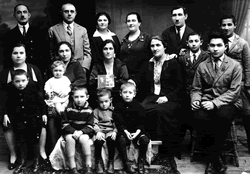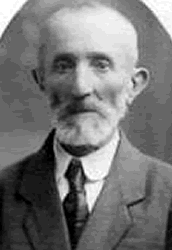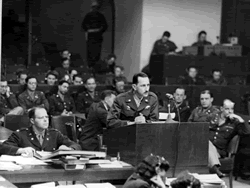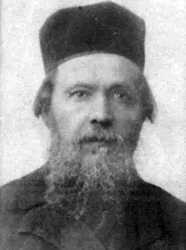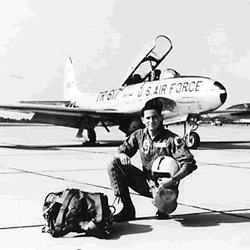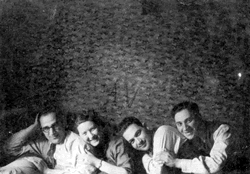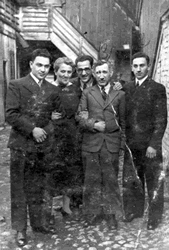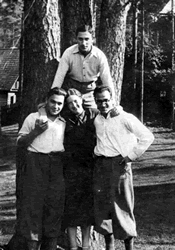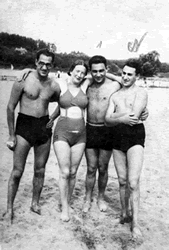#brdno-1
Berta/Batia Brudno and her son Simcha of Shavli, visit
their Brudno relatives in Vilna c 1926. Top from right; Nechemia,
Yehuda ( son of Avraham, grandson om Yehuda Leib Brudno), Berta (
oldest daughter of Avraham) , Sima/ Simcha ( youngest daughter of
Avraham) David ( son of Avraham) Mr. Bladndes ( son in law of Avraham)
middle; Moshe and Simcha (sons of Yehuda), Sarah ( wife of Yehuda)
Berta ( holding picture of her husband, Aharon of Shavli (son of
Avraham Brudno ) , Davids' wife, Sarah Blandes ( daughter of Avraham
Brudno) Bottom; Leyzer Blandes, Simcha Brudno (son of Aharon and berta
of Shavli) Yisrael and his brother (sons of David), Nechemia Blandes.
All but Simcha Brudno ( son of Aharon) perished in the holocaust.
#brdno-2:
Vignetted studio portrait of Sholem Brudno, one of
the town of Smorgon oldest men. 1937.
#brdno-3:
Walter Brudno, a Private in the United States Army, presents a part
of the United States case at the Nuremberg War Crimes Trials. Donor:
Robert Jackson
#brdno-4
This is my great-grandfather Ezekutiel Brudno from Rozalimas
www.shtetlinks.jewishgen.org/.../steinberg.htm
Testimony of Simcha Brudno
by phone interview in September of 2005
#brdno-5:
Air Force Maj. Edward Alan Brudno, assigned to the 68th Tactical
Fighter Squadron, was shot down over North Vietnam on 18 October 1965.
He spent 7-1/2 years as a prisoner of war before being repatriated in
1973. www.nyvietnamveteransmemorial.org/vvm/memoria...
#brdno-6
A visit to Kovno, (c 1940) The Brudno brothers, probably, Moshe (second from right) next to his wife and Nechemia (first on the right),The photographs were found in the pockets of murdered Jews in the Klooga camp, after the liberation.
#brdno-7
Brudno family 1937 Vilna. The photographs were found in the pockets of murdered Jews in the Klooga camp, after the liberation.
#brdno-8
The Brudno brothers. The photographs were found in the pockets of murdered Jews in the Klooga camp, after the liberation.
#brdno-9
The Brudno brothers. The photographs were found in the pockets of murdered Jews in the Klooga camp, after the liberation.
Avraham had twelve children: Yehuda, Berta, Aharon, David, Sima, Sara
and (Simcha did not tell me the other names). My maternal grandfather
was Simcha Feive Farber. Both of my grandmothers were born into the
Soleznik family of Vilna. They were sisters; Nechama was married to
Avraham Brudno and Rivka was married to Simcha Feive Farber. My mother
was Sheina Tesia (also known by Berta nee Farber) and she was born in
Vilna in 1891. My father was Aharon Brudno and he was born in Vilna in
1879. My father's father, Avraham (son of Yehuda Leib, my
great-grandfather), was born in 1844 and died in 1925. ("I have just
arrived to the age in which he passed away"). The Brudno family was
originally from Smorgon (then in the Vilna region), the town where
most of the Brudnos originated. Since Yehuda Leib received a good job offer in Shavli, Aharon followed
his brother Yehuda to Shavli in 1911. They both found jobs in a
tannery (a factory to process raw leather), which belonged to a Jew by
the name of Chaim Frankel. The firm was the biggest factory in the
region. Before my father left Vilna he married my mother, Sheina Tesia
(his first cousin). Their mothers were sisters. Both of my parents,
Aharon and Berta, worked at the tannery, albeit in different branches.
Both worked as bookkeepers and as part of their benefits, they
received a home on the grounds of the factory. The address of the
house was Vilnius Gatve #72. In 1912 they had their first child, a
daughter, whom they named Nechama after her grandmother who had passed
away. In 1914, at the outbreak of the First World War , my father
Aharon was taken to serve in the czars' army. Many of the Russian
soldiers looked at him strangely since he was the first Jew they had
ever met. He spent most of the time fighting on the front and said
that more Russians were killed by each other than by the Germans.
Every day he would write a letter to my mother, his beloved wife.Shavli is located in the western part of Lithuania ¨C not far from
Germany. In the spring of 1915, the Russian leaders decided to expel
the Jews to the interior of the country, claiming that the Jews had
helped the Germans and blaming them for the failures of the Russian
army. The Jews of Shavli were forced onto trains to Poltova and later
to Kharkov where my mother Berta and sister Nechama spent their days
until 1918. When the war ended, they returned to Shavli and reunited
with my father, Aharon. Yehuda Leib Brudno ( my uncle) did not come
back to Shavli. He returned to Vilna, where he later perished with his
entire family. For many years, the family could not see each other
because Vilna had become part of Poland. Lithuania and Poland had very
bad relations and they did not allow visitation between the two
countries.... For the rest go to;http://www.eilatgordinlevitan.com/siauliai/siau_pages/siau_stories112305.htm
---------------------------------------------------
The Book of Clevelanders, A Biographical Dictionary of Living Men of
the City of Cleveland, Burrows Book Company, 1914Brudno, Ezra Selig; author; born in Lithuania, May 28, 1877; son of
Issac and Hannah (Model) Brudno; attended Adelbert College (Western
Reserve University), 1896-1897; at Yale, 1898-1900, reading law and at
same time pursuing academic studies; finished law studies at Western
Reserve University, 1900; unmarried; began practice of law in
Cleveland, 1901; assistant district attorney since 1909; Republican.
Author: The Fugitive, 1904; The Little Conscript, 1905; The Tether,
1908. Contributor to magazines.http://www.accessgenealogy.com/scripts/data/database.cgi?file=Data&report=SingleArticle&ArticleID=0030556
Part of the appeal of the book lies in its extensive use of The
Jugglers, a novel written by the Cleveland lawyer-cum-writer, Ezra
Brudno, which satirizes the Cleveland legal profession. Published in
1920, the novel recounts the introduction of an idealistic, young
lawyer to legal practice and particularly workmen's injury proceedings
in Cleveland. Bellamy is lucky to have such a delightful foil to his
more serious argument throughout his monograph. It provides an amusing
and irreverent portrait of the rather seamy underside of legal
proceedings in Cleveland in the period covered by the monograph. This
makes a potentially dry subject, in fact, very readable
http://72.14.253.104/search?q=cache:H9bkpE-xW4gJ:www.findarticles.com/p/articles/mi_m0348/is_n2_v39/ai_20951196+brudno+Cleveland&hl=en&ct=clnk&cd=5&gl=us
----------------------------------------
http://72.14.253.104/search?q=cache:bDBNAlJmxqwJ:www.usafreedomcorps.gov/about_usafc/newsroom/local_vols_dynamic.asp%3FID%3D399+brudno+Cleveland&hl=en&ct=clnk&cd=1&gl=usOn his arrival in Cleveland, Ohio on Monday, President George W. Bush
will meet with Eugene Brudno, a Cleveland senior and World War II
veteran who has dedicated more than 25 years as a volunteer to helping
families coping with mental illness. In his State of the Union
address, President Bush called on all Americans to dedicate at least
two years of their lives¡ªthe equivalent of 4,000 hours¡ªin service to
their communities, our country and the world. His goal is to give
Americans a way to respond to the evil of terrorism with acts of
compassion. President Bush is recognizing individuals around the
country who are answering the call to service, and will recognize
Brudno as an example of the dedication to service he is hoping to
instill in all Americans through his USA Freedom Corps initiative.Brudno has dedicated countless hours of volunteer service to
supporting families with mentally ill children. Having owned a produce
company, Brudno is known in many Cleveland neighborhoods as "Eugene
the Eggman." Brudno began volunteering with Jewish Family Services
more than 25 years ago and has founded several organizations to help
families cope with mental illness.Brudno and his wife, Irene, are the co-founders of the Alliance for
the Mentally Ill of Metro Cleveland. He is also a co-founder of PLAN
(Planned Living Assisted Network) of Northeastern Ohio, which assists
adults with mental illnesses when their parents or caretakers pass
away. The organization serves 120 families in Ohio.Reporters interesting in interviewing Brudno should contact Kathy
Levine with Jewish Family Services at (216) 849-5515.------------------------------------------------
Eliana SydesMy Email : Bradlaw.limited@virgin.net
Age : 39comments : My husbands family came from Smorgon. Robert Brudno, his
wife Hannah and children Isaac and Henry Jacob arrived in England
between 1867 and 1873. Roberts parents were possibly called Henry and
Breney.
date : 16/7/2004
-----------------------
Aleksandr L'vovich Brudno (Alexander Lvovich Brudno) (Russian:
§¡§Ý§Ö§Ü§ã§Ñ§ß§Õ§â §§î§Ó§à§Ó§Ú§é §¢§â§å§Õ§ß§à) is a Russian computer
scientist, best known
for fully describing the alpha-beta (¦Á-¦Â) search algorithm.[1]] Biography
Brudno developed the "mathematics/machine interface" for the M-2
computer constructed in 1952 at the Krzhizhanovskii laboratory of the
Institute of Energy of the Russian Academy of Sciences in the Soviet
Union.[2][3] He was a great friend of Alexander Kronrod.Brudno's work on alpha-beta was published in 1963 in Russian and
English.The algorithm was used in computer chess program written by Georgy
Adelson-Velsky and others at the Institute for Theoretical and
Experimental Physics (ITEF or ITEP). According to Monty Newborn and
the Computer History Museum, the alogorithm was used later in Kaissa
the world computer chess champion in 1974.
[edit] Early alpha-beta
Allen Newell and Herbert Simon who used what John McCarthy calls an
"approximation"[4] in 1958 wrote that alpha-beta "appears to have been
reinvented a number of times".[5] Arthur Samuels had an early version
and Richards, Hart, Levine and/or Edwards found alpha-beta
independently in the United States.[6][citation needed] McCarthy
proposed similar ideas during the Dartmouth Conference in 1956 and
suggested it to a group of his students including Alan Kotok at MIT in
1961.[7] Donald Knuth and Ronald W. Moore refined the algorithm In
1975[8][9] and it continued to be advanced.
-----------------------------
Mikhail Brudno 310
44 , self made
Source: oil
Net Worth: $1.8 bil
Country of citizenship: Russia
Residence: Moscow, Russia
Industry: Oil/Gas
Marital Status: married , 2 children
Bachelor of Arts / ScienceTrained as a computer programmer; was working for the foreign trading
arm of the Soviet Ministry of Geology in 1988 when his colleague,
Leonid Nevzlin, introduced him to Mikhail Khodorkovsky. One of the
founding members of what later become Group Menatep¡ªa holding company
headed by Khodorkovsky, with interests in oil giant Yukos as well as
banking, telecommunications and fertilizers; headed up Yukos' refining
and marketing operations until early this year. Along with other
Menatep shareholders, recently transfered shares to third parties.
Ducking charges of theft in connection with the privatization of
fertilizer company Apatit (the same charges leveled against his
partner Khodorkovsky, who is in jail); Brudno currently lives in
Israel.
-----------------------------------
His wife, Tante Sarita, was distantly related to the Brudno family of
Cleveland and perhaps that is why they came to Cleveland. The Brudno's
already had a ...
www.eilatgordinlevitan.com/vileyka/vil_pages/vil_gb_archive.html -
250k - Supplemental Result
By Keneth Zucker
It all really started with Myra Rothenberg of New York.
She embarked on the task of seeking to establish that all the families with the surname "Brudno" are connected. That name is not common but not sufficiently uncommon to automatically establish that anyone bearing it must be related.
It so happens that my wife's maiden name was Brudno. I had always sworn that I would not get involved in her family history. I had enough to do with my own. I would leave her side of it to her and and my daughter. It was not, of course, the feeling that if I did so nothing would be done. Certainly not. However the genealogical bug is inclined to bite. It bit me. So I embarked on the extensive ramifications of the descendants of my wife's grandfather Yekutiel Zussman Brudno, Rabbi of Rozalimas in Lithuania from about 1880 to 1923. Hence the net widely flung by Myra enmeshed me.
So it was that I stumbled across a puzzle that Sherlock Holmes himself might have found worthy of a solution; because not one but four Brudnos (or in one case to be precise Brudnow) came to England from Eastern Europe between about 1867 and 1913. The records at Kew revealed that three of them individually and at different times adopted the name of Bradlaw. That in itself might suggest a connection. But although several of their descendants believed that there might be one no one could produce any evidence.
The four bearers of the name each had an interesting history
The eldest Robert Brudno arrived here in about 1867. He had been born on 22 February 1840 in Smorgon in what was then part of the Russian Empire and is now in Belarus. By 1881 he was using the name Robert Bradlaw. He had moved with his family to Dublin in 1880 where he practised as a Dentist. He became one of the leading members of the Dublin Jewish community. He was the founder of the St. Kevins Parade synagogue and the Dolphins Barn cemetry where he is buried. An obituary referred to him as the "Prince of the foreign community". One of his grandsons was Sir Robert Bradlaw, Dean of the Eastman Dental School from 1959 to 1970.
Eliana Sydes who is married to a great great grandson of Robert Bradlaw has written a thoroughly researched and very comprehensive history of Robert Bradlaw and his descendants. That history has provided me with many facts and leads without which this article could not have been written.
Leopold Brudno was born in 1878 in Plunge in Lithuania. He took the name Lawrence Bradlaw in 1895 prior to going on stage to play character parts in Shakespearean companies.
Henry (formerly Hirsch) Brudno was born in Rozalimas in Lithuania on 5 March 1891, the seventh and last but one child of Yekutiel Zussman Brudno. He received semicha from the Slavodka Yeshiva at the age of 19. He came to England in 1913. He matriculated at Jews College and then studied medicine at Queen's University, Belfast. He supported himself in his early years here by teaching Hebrew and Talmud. One of his pupils was Israel Brodie, later Chief Rabbi. After years as a locum in the Welsh valleys he became a highly respected South East London GP. He alone kept the name Brudno which is how my wife his daughter acquired it.
George Brudnow was born on 15 September 1892 in Propoisk in the district of Mogilev which was then part of the Russian Empire but is now in Belarus. At some time before he obtained his Certificate of Naturalization on 14 May 1927 he had adopted the name George Bradlaw. He was called to the Bar and spent most of his working life as legal counsel to the Palestine (Israel) Electric Company.
It is part of the puzzle that the name "Bradlaw" was adopted by three of the Brudnos. The fact that they did so at dates set well apart could imply that it was by more than a coincidence
Eliana Sydes ingeniously suggests (p.15 of her history) that Bradlaw could be derived from the Hebrew name Brudno. If that were correct it could rule out the inference that all took the same name by reason of a family connection. However Brudno is not a Hebrew name but is Polish. Even if it were Hebrew it would be quite impossible to derive Bradlaw from Brudno. The reason most Jews changed their names was to replace a foreign sounding name with an English one. Often, of course, they looked for a name which might reflect in some way their original name. Bradlaw meets that purpose but many other names could have been chosen. Eliana's suggestion that Robert Brudno was impressed by the MP Charles Bradlaugh, newly elected in 1881 and adapted his name may well be correct: particularly as the name Bradlaw appears to have been used by Robert for the first time in the 1881 census.
The change of name is a pointer but not by itself sufficient to establish a link.
I believe that there is strong anecdotal evidence supported by available records to show a connection between the families of Robert Bradlaw, George Bradlaw and Henry Brudno. The keys are the city of Dublin and the name Sylvia. Who was she?
Robert Bradlaw's connection with Dublin I have already set out.
Looking back through my correspondence I came across a letter from George Bradlaw's daughter Ruth Giller who had written to me in 1998. She said that her father was born Eliachum Getz Brudno. She wrote "My father spoke of family in Dublin (Sylvia?)…"
If I could find a Dublin Sylvia in Robert Bradlaw's family I would have gone a long way to establishing a connection between the families of Robert and George Bradlaw.
Sylvia and Dublin also ocurred in a different context. My wife Ruth told me that she could remember two members of the Wigoder family who were relatives of her parents visiting her home in Brockley,South East London in the early 1950s. Her memory is that their first names were Robert and Sylvia and that Robert Wigoder had a medical practice in Catford. This was particularly intriguing because the Wigoders were a well known Dublin family.
Could I establish a link between the Wigoders and the Bradlaws? If I could I would have linked the family of Henry Brudno to that of Robert Bradlaw. Obviously as the surname was Wigoder it could only be through a daughter of Robert Bradlaw marrying into the Wigoder family.
I turned back to Eliana's history of her family. She relates that Robert Bradlaw's elder daughter was Jessie Bella Bradlaw born on 22 December 1872.
So to the archives of the Jewish Chronicle. Its edition of 6 October 1893 includes the announcement of the engagement of Jessie Bella Bradlaw to S.G. Wigoder MD of Dublin.
Eureka! There is the Bradlaw/Wigoder connection. But what about Sylvia?
The Jewish Chronicle again came to the rescue. On 1 June 1934 it recorded the sudden death of Dr. George Selig Wigoder aged 70. He had been president of the Dublin United Hebrew Congregation. It referred to two sons Dr. L Wigoder and Mr. R Wigoder and a daughter Dr. Sylvia Wigoder. We have now identified a Sylvia - the granddaughter of Robert Bradlaw. But was she the Sylvia who visited my wife's home.
The Jewish Chronicle again. On 15 April 1977 it carried a short obituary of Dr. Robert Wigoder describing him as a Catford GP born in Dublin in 1906. He was a founder member of the Catford Synagogue with which he was associated for over 40 years.
The tie in is complete because of my wife's memory that their visitor Robert Wigoder had a Catford medical practice and that his sister was Sylvia and because of Ruth Giller's reference to "family in Dublin (Sylvia?)…"
To my own satisfaction at least I have established that both the families of George Bradlaw and Henry Brudno are related to that of Robert Bradlaw.
I have not so far in this article established a direct connection between the families of George Bradlaw and Henry Brudno. But this part of the puzzle is easily solvable because my wife recalls that George Bradlaw and his family visited her family on a number of occasions at their home and that she and her family were invited and went to the wedding of George Bradlaw's niece Miriam (the daughter of his sister Bessie) when she married the historian Lionel Kochan. They were always known as relatives.
To sum up - there is evidence that both the families of George Bradlaw and Henry Brudno are related to the family of Robert Bradlaw. The family of Henry Brudno is related to the family of George Bradlaw. When there is added in the fact that when they changed their names both Robert and George adopted the name Bradlaw the case for a connection between all three families is a strong one.
A connection with Lawrence Bradlaw has only the change of name to support it.
I am, of course, conscious that I have not yet found in earlier generations direct evidence of a common ancestry: but I already have two further pieces of evidence which points to one.
Robert Bradlaw came from Smorgon. Smorgon Yizkor book entries show a number of Brudnos. The death certificate of Yekutiel Zussman Brudno's wife Chaya Hella Brenner describes her as "of the Smorgon community". I strongly suspect that Yekutiel Zussman himself came from Smorgon where he found his wife and the records of that shtetl, if I can find them, will reveal his common ancestry with that of Robert Bradlaw.
Finally George Bradlaw's father was Chaim Yitzhak Brudno born in 1861.
Two of the grandchildren of Yekutiel Zussman Brudno and Chaya Hella Brenner who married in about 1879 were named Chaim Yitzhak; the same names as those of George Bradlaw's father. Another common factor between those two families given the practice of naming children after dead relatives.
There is a great deal of work still to be done. Watch this space.
Ezra Selig Brudno;
Writer Ezra Brudno (b. 1878 in Volozhin- 1855), great-grandson of Rabbi Manashe ILIER ( Rabbi Menshe from Ilja- I have his story on my site)
Rabbi Menashe was from Smorgon, the second most well known student of Hagaon MeVilna, Rabbi Manashe was related to well known families in Vilna. Brudnai Yizhak Izik son of Meir. 1888 Smorgon- 1956 Tel Aviv
Ezra' books: A guide for the misguided, Ghosts of yesterday; a reappraisal of moral values and of accepted standards in this changing world, One of Us (1912, The fugitive; being memoirs of a wanderer in search of a home.
page 125; Ezra Selig Brudno;
Writer Ezra Brudno (b. 1878 in Volozhin- 1855), great-grandson of Rabbi Manashe Ben Porat. Rabbi Menshe from Ilja ( born in Smorgon 1767- 1831) I have his story on my site.the second most well known student of Hagaon MeVilna, Rabbi Manashe was related to well known families in Vilna. One of his daughters married a brudno. Some of her family members lived in the midwest.
Rabbi Menashe was from Smorgon, .
Ezra' books: A guide for the misguided, Ghosts of yesterday; a reappraisal of moral values and of accepted standards in this changing world, One of Us (1912, The fugitive; being memoirs of a wanderer in search of a home.
page 125; Brudnai Yizhak Izik son of Meir. 1888 Smorgon- 1956 Tel Aviv
A banker as was his father before him.Studiedinthe Slobodka Yeshiva.Studied Philosophy and Economy at the Bern U. A Zionist headed the Z. S in Khrakov. 1921- 1926 headed the main Jewish bank in Lithuania.Came to Israel in 1926 headed bank Hapoalim and Hamashbir Lazarchan.
BenZion Brudni headed the Jewish Bank in Kibrati, LIthuania. The bank had 150 members in 1929
about Rabbi Menashe;
I believe Uncle Hirshel, the father of Dinah Slavin, Minnie Baskind,
Beckie Minister, Rose Kohl, and Manny was the first to arrive in the
United States. His wife, Tante Sarita, was distantly related to the
Brudno family of Cleveland and perhaps that is why they came to
Cleveland. The Brudno's already had a large stogie factory in
Cleveland. I remember it on lower Broadway. It must have been five or
six stories high. When Uncle Hirschel came to Cleveland, he
immediately went to work for the Brudno's. My Aunt Sarita was very
proud of her ancestor, Menasseh of Ilya, who is mentioned in the
Encyclopedia Britanica as one of the five famous pupils of the Vilna
Gaon. That is why there are so many Emanuel's in their family.
From Smorgon Yizkor book:
They had two daughters, and a son named Joseph. It was his wife' work and
devotion that made it possible for rabbi Menashe to publish his life's
works. Although he was often asked to lead and teach different
congregations, he declined. He was skeptical of anyone accepting and
following his radical teachings and life altering beliefs, recognizing
their innovative nature. Rabbi Menashe knew that nothing was harder
for people than rejecting old habits and embracing the new.
"I, the writer of these lines, have seen the distress and sorrow of
the beings in this world. Their sorrow and destitution make my heart
ache. Although they are many and I cannot name them all, I will
shortly articulate my observations. Everywhere, oppression is evident.
The large devours the small, the strong is empowered, as the weak
perishes. Yet, the greatest of all evils is poverty. People fight to
make a living every day, while few succeed. Famine is all too common.
The masses walk the streets, plagued by hunger and thirst, homeless,
seeking shelter from the elements. All this is compounded by sickness
and plagues, God help them. This is the reality I witness day after
day, and which fills my heart with sorrow. Wherever I turn, this
reality haunts me and as much as I try to find a solution, I am
forever helpless and distressed. Every day I pray that God will show
me the way to bring welfare to all." (taken from rabbi Menashe's
preface to his book Tikun-Klali).
In his treatise, rabbi Menashe prays to God to find a solution for
societies ailments,a way to set right its inherent corruption.
Questioning his own intelligence, he ponders the morbid condition of
humanity. In "Sama DeChayai" he is convinced he has found the
solution, the way to correct the injustice of the human condition, by
the application of the rules of justice and logic.
Prone to question every new phenomenon he encounters, rabbi Menashe
was avid about sacrificing his old ways of thought and action for
innovative ones, which never failed to amaze and startle his peers.
Aware of the transitive nature of life, he was burdened by the plight
of man and by the thought of what would come to be after he was gone.
So much so, that he no longer enjoyed the simple things in life. He
was dismayed by people's complacence and lack of forethought, thinking
only of the present moment, not giving a second thought to what the
future holds for them. The rich, content in their riches,the wise,
content in their intellectual endeavors, and the warriors in their
victories.
Page 6
Although of different walks of life, they had one thing in common.
They all focused on the present. all satisfied with their lives, like
animals fattened before they are fed on, unaware of the slaughter that
awaits them. These up thoughts would forever occupy rabbi Menashe's
mind, until he came up with what he believed, was a solution which was
in accordance both with the Torah and with common sense (Sama
DeChayai, page 15).
Rabbi Menashe was a man of great conscience and of fine perception.
One could justly say of him that he had more awareness and sorrow for
the human condition in his smallest finger, than others had in their
whole body. His comprehension of the Jewish moral code was so
complete, that it not only touched upon the righteous interaction of
men, but also covered our interaction with the animals, which he loved
and befriended. To his mind, we were all children of God, forever
bound in the same universe expected to heed God's law. Rabbi menashe
did not condone cruelty to animals, and believed their suffering and
ours were not to be differentiated. He compared man not only to a tree
whose roots reach deep into the ground that sustains it, as written in
the book of Psalms, but also to the worms and the maggots, as
expressed by king Solomon there in chapter 22, verse 7: "But I am a
worm and no man". Rabbi menashe believed that an unseen bond,
impervious to the naked eye and to conventional scrutiny, exists
between both man, nature, and all living beings, maggots and all.
His religious ethics surpassed the boundaries of humanity and
permeated all realms of existence. Rabbi Menashe extended the Jewish
directive for good-will and universal comeradship beyond human
relations, to include the universe in its entirety. He understood this
next verses from the book of Proverbs in this light: "The lord is good
to all, and his tender mercies are over all his works" (there:145:9).
"...O Lord thou preservest man and beast." (there:36:7)
Rabbi Menashe recognized the diversified nature of people. "Some are
stoic, unless their own well being and goals are at risk. Others are
concerned with the well being of there family and friends, as well.
This is true of the majority of people. But the enlightened, those who
appreciate the hardship of sorrow and suffering, God bless them, are
passionate about the well being and happiness of all who can
experience pain, and there heart goes out to all animals as well as
all men." (Alphey-Menashe, pg. 58. Vilna, 1904)
Rabbi Menashe believed it was every man's responsibility to make every
effort to polish his own personality, and to ford his courage to such
a degree that he realizes the interconnectedness of all beings, and
see them all as essential parts of one great vessel, (there, page 16).
"...and as I have noted, it is our inherent responsibility to aspire
to, and reinforce all that is good, and to distance the harmful...we
should distinguish between the transitive good, the longer lasting
good, and both these from the eternal, or ultimate, good...
Page 7
and to sacrifice the first two, for the achievement of the latter. The
enlightened person, one who can picture both the joy and the pain
experienced in life, cannot help but wish for the wellbeing of all
those who can experience them, and nothing less. Anything else would
be almost inconcievable. Such a person that sees the essense of all
beings and of life itself, will no doubt sense all the sorrow and the
suffering of all the beings, as if they were their own. No shade of of
distress or agony would be foreign to him, wether he had experienced
them himself, or wether he had imagined them.
Rabbi Menashe Ben Porat was such a man. He truly felt that as long as
there was one distressed worm in the world, stuck in crevis too narrow
for it to advance, to withdraw, or to turn – the world was not right
nor truly mercifull, and he, rabbi Menashe could not be at peace, nor
complacent, nor serene.
Rabbi Menashe's ultimate goal was to correct all that is wrong in the
world, and to bring Tikun to all, by spreading good and dispersing
harm. He would rarely delve into his personal needs or comfort and
always focused on the general good. "What am I, and what is my value
in comparison to the countless other natural beings living in this
world? And if God had blessed me and my family and my friends with
health and wealth and success for all times, yet someone in the world
was still miserable, I would renounce it all.
How could I enjoy my life when somewhere there is some living being
that is unable to realize himself completely, as God intended? Unable
to seek and realize the good, as he percieves it, in accordance with
his true nature. I am certain that this is not what God meant by
directing us to pursue the correction of the world(Tikun Klali)."
(from the preface of Ha'amek she'ela/Seeking the Truth).
Rabbi Menashe could never differentiate his well being from the common
good. The transitive nature of life made this bond even stronger for
him, percieving his own life as meaningless in comparison to his
mission to rid the world of misery and suffering. He spoke of a story
his mother once told him of she had nursed her sick baby girl on Yom
Kipur's eve. Agonized by her suffering, she left the girl with a
servant, and crept off to the synagogue to pray.
--------------------------------------------------------------------------------------------------------------
Page 8
It was then that his father was preparing to go pray at the synagogue,
dressesd in white, covered by his Talit, that he heard the little girl
cry, and realized his wife had left the girl with the servant and left
the house. He then removed his Talit and outer garment, and sat down
by the infant's cradle, to gently rock it and give her her medicine.
He sent the servant to tell his wife that he would remain at home, and
would not leave the baby's side, until she returned. His point being
that nursing the sick is of greater importance than the practice of
religion.
Rabbi menashe often cried out to God, imploring him to help him
understand the miserable reality of human existence. He couldn't
understand why God would create a world in which man was so powerless
against plagues, hunger, and poverty. A world in which parents can't
afford to feed their young. And if one generation sins, why must the
next pay for their sins? And why some should live in lavish wealth,
while others fight day in and day out, to just barely survive? (from
Sama DeChayai)
Tormented by these social queries, he knew no peace, until he found
what he believed was the answer. Given his radical approach to these
issues, it was no wonder that he was targeted by many fanatics.
One day, rabbi Menashe visited a town nearby the city of Smorgon,
where he was born. Although he did not appreciate the resident rabbi,
nor did he agree with his teachings, he decided to visit him, as not
to appear disrespectful. He was startled to find him sitting alone in
his court house. "Why", asked rabbi Menashe, "would your honor agree
to sit alone in judgement? Have you forgotten the written rules
forbidding this?" (Avot:84, chapter 8). "But can you not see", replied
the rabbi, "that I am not alone? I have before me the great book
Shulchan Aruch, the cornerstone of all laws. So, you see, we sit here
together in judgement." Rabbi Menashe then replied, with the slightest
smile on his lips, "I am surprised that your honor would share his
court with one who is oblivious of his existence...?"
When the great contreversy broke out between the Hasidim and the
traditionalists who bitterly oppossed them, rabbi Menashe took no part
in their fanatical persecution of this innovative school of thought.
Unwilling to judge them simply because his peers found them
abominable, he decided to go and see for himself what the Hasidic
school of thought was about, and if there was any basis for the claims
made against them, and visited the city of Liyadi, home of rabbi
Sneyor Zalman.
Avreml Brudno
Avrom or Avreml Brudno was a well-known musician and composer in the
Vilna ghetto. Many of the ghetto’s most successful songs were his
creations, including the melody to ‘Friling’ (Spring), one of the rare
love-songs written in 1943 by Shmerke Kaczerginski, as well as the
melody to Avraham Sutzkever’s ‘Unter dayne vayse shtern’ (Under your
white stars). Both of these songs, originally composed for
performance in one of the ghetto’s musical revues, were enormously
popular. The composer perished in the Estonian concentration camp
Klooga.
Sources
Freund, F., Ruttner, F. & Safrian, H. eds., Ess Firt Kejn Weg Zurik.:
Geschichte und Lieder des Ghettos von Wilna, 1941-1943, Vienna: Picus.
Katsherginski, S. & Leivick, H. eds., Lider fun di Getos un Lagern,
New York: Alveltlekher Yidisher Kultur-Kongres.
Eilat,
First off, I love your name and the place in Israel!
I am Myra Rothenberg currently near Seattle (grew up in LA). My GM was Sophie Brodie ( Brudne) from the city of Vilna, who married Morris Wasserman.
Years ago, I paid a researcher to help me gather my direct line of Brudnes and Wassermans. Well, I now have tons of small family-ettes of Brudnes/nos/noys/neys/nyaks/, etc. etc.
Recently, I have been working with a guy who is re-researching and editing that book of Clevelanders of Brudnos. I hear tell there are some Brudno folk in Israel also. I have kids in the West Bank and my daughter-in-law is a new teacher this year, English. My son is a Captain in the IDF, psychologist.
I’ve known about your website ( fabulous) for a long while now.
A couple of years back, maybe 2?, I started to try and find more of these Brudnos and came upon lots of families in Australia and in London and in South Africa and various parts of America.
I can send you my tree as it is and you can see what I have. I have a Brudno back to 1700, Mousha.
Ancestry has 100 spellings of Brudne, some we wouldn’t recognize at all, but soooooo many others. There was a different spelling for every little part of Lithuania and Belarus, etc.
Perhaps you know all this already.
I’d love nothing more than to piece all of our parts together into one big tree!!!!!!!!!!!!!!!!!!!
I’m tossed as to how the heck this o would ever happen. First off, I am going to receive the Clevelander disc and see what I comes up.
Thoughts?
Myra
From: Jared Brudno <jgbrudno@sbcglobal.net>
Abraham Brudno owned the cigar factory mentioned by Yahadut Lita on
page 125 of text on Brudno page. He was my paternal grandfather,
Fannie Brudno was his wife, and had sons Milton, Harold, Leonard and
Walter Brudno. Walter was lawyer at Nuremberg. He was my father. Hope
more information becomes available about this part of family. Jared
Brudno
From: Jules Feldman
My wife's great-grandfather was Aharon Max/Mottel Brudno born in Godutishki (today Adutiskis) in Lithuania. He was born c-1852 and his father's name was Elia. He was married to Leah Citron and in 1897 they were living at Kreslavskaya 4 , Dvinsk and he was a tanner. In 1921 they migrated to Jerusalem where they both died in 1938.
We know nothing of Aharon's parents or siblings.
However he and Leah had 5 children
Anna ( my wife's grandmother) married Shneur Zalman Rivlin (born Kochanova, Belarus) lived in Poltava, Ukraine and then Benderi, Bessarabia and then migrated to Ramat Gan in 1921
Raya married Naum Tslaf , they lived in Leningrad where he died in 1942 and she moved to Odessa after WW2
Grisha Brudno lived in Poltava where he died in 1954. His 4 sons: Lev lives in Beersheva, Eduard died in Poltava in 1994 and his daughter, Tatanya still lives there; Henrik in Toronto ; Yuri in LA.
Eva married Sender Wildavsky, lived in Dvinsk until 1928 and then migrated to NY.
Minna married Moisey Lvovich, lived in Odessa until 1979 and then migrated to NY.
Best,
Jules
My name is Janet Bradlow. My grandfather, whose name was Boruch Brudno was born in Smorgon, Russia (now Belarus) in 1895. He immigrated to the United States in 1916. He changed his name to Robert Bradlow when he became a citizen in 1924. Boruch had a half-brother named David Adolph (Brudno) Bradlow who was born in 1876 in Smorgon. According to a book written about David Bradlow (“The Story of Bradlows” by Eric Rosenthal), David immigrated to England, then to Dublin and finally to South Africa where he eventually established a major furniture store in Johannesburg. The book states that David’s “father . . . had built and repaired railway stations for the Government, erected bridges and laid roads.” We believe the name of Robert’s and David’s father was Moisei (Moses) Jonah Brudno who was born around 1840 and died in 1926. A son of David Bradlow, Frank Bradlow who was a historian in South Africa, indicated in a family tree that the ancestor of the Bradlow (Brudno) family was Menashe Ben Poirat Ben Joseph (1767 - 1831). Unfortunately, I have not found any source documents to verify this statement.
I came across your website http://www.eilatgordinlevitan.com/kurenets/k_pages/brudno.html. Your website states “The Brudno family was originally from Smorgon (then in the Vilna region), the town where most of the Brudnos originated.” I was wondering if your Brudno family shares a common ancestor with my Brudno family. My father (Leon Bradlow), who will turn 93 on the 21st of this month, is willing to take a Y-Chromosome DNA Test if members of another Brudno family have taken or are willing to take this test.
I am not sure if you are related to the Brudno family or if you prepared the genealogical research. However, if you know of someone in your Brudno family who has taken or is willing to take the Y DNA test, please send an email to me at schmittbradlow@rcn.com. If you do not wish to exchange any information, a negative response to my message would be appreciated.
If you have any questions about me or my family, you can Google search me (Janet Bradlow), my father (Leon Bradlow), David Bradlow and Frank Bradlow. You will find substantial information about us and other family members.
